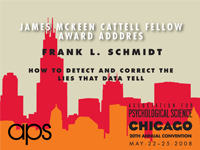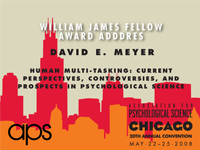APS: Through the Eyes of the Presidents

In a session fittingly chaired by APS founding Executive Director Alan Kraut, a panel of 13 APS Past Presidents shared some of their most memorable moments leading the organization during the session “APS: Through the Eyes of the Presidents” at the APS 20th Annual Convention. This once-in-a-lifetime gathering also chronicled many of the dramatic events that led to the formation of APS.
Janet Spence (1988-89) recalled her “two magic moments” as President during APS’s inaugural year. The first was the moment APS sprang into being. After fifteen years of struggling to have scientific psychology re-established in the APA, the formation of APS was a “truly exhilarating and unforgettable moment.” Nothing could stifle her excitement at the time, not even the opponents who taunted her and other founders at the APA convention. The second magic moment was at the first annual APS convention. “The excitement was palpable,” Spence remembered, even though the poster sessions were held in a “crummy basement” of a motel in Arlington, Virginia.
Not all of the Presidents remember being so embroiled in the APA/APS split. Hailing from the West Coast, Gordon Bower (1991-93) tried to stay away from the politics of it all and relished in maintaining his membership with several groups, including APA. “Psychologists need as much fire power as we can get,” he said. During his presidency, Bower, who will be featured in next year’s Inside the Psychologist’s Studio event at the convention, predicted that APS membership would level off at around 13,000 to 14,000 members and looking back on that says, “APS has grown far beyond its initial prophecy.”
 |
|
Marilyn Brewer, dressed for the event in vintage APS regalia, speaks during “APS: Through the Eyes of the Presidents” while Janet Spence and Alan Kraut listen. |
Marilyn Brewer (1993-95) dressed for the occasion in her “vintage” APS t-shirt from the first annual convention. She remarked that that after the initial exhilaration of the success of their new organization subsided, a lot of them were left asking, “OK, now what?” Could they fulfill the duties of a national psychology organization designed to encompass an array of subgroups? When it came to naming and developing the mission of the organization, there was much discourse over whether APS would be an organization of psychological sciences or just psychological science. The consensus was to focus on psychological science as a whole rather than develop as a federation of sub-fields.
In true scientific fashion, Kay Deaux (1997-98) related her APS experience from a developmental perspective. In the beginning, everything was novel and exciting, then during its adolescent years APS struggled with its identity, including its name, the development of the journals program, and who and what the organization wanted to represent. Now, as an adult association, APS has its eyes on the future. Expecting that future to be a long-lasting one, Beth Loftus (1998-99) and Deaux expressed their enthusiasm to write APS into their wills. Loftus, just recovering from a perforated appendix, exclaimed, “When I was lying in the hospital bed, I felt relieved that I had already put APS in my will!”
John Darley (2001-02) and Robert Bjork (2000-01) commented on the resounding sense of urgency for psychological science to have a voice when APS was created. Having dealt with the “baroque” structure of APA, Bjork applauded the “lean and nice” structure of APS saying that when you have an idea, you can mention it to Alan Kraut or Sarah Brookhart [APS Deputy Director] and soon after you’re sure to see action taking place. In fact, when the idea for the journal, Psychological Science in the Public Interest, was brought to the table, “it was met with a drop-everything response,” Bjork recalled. Henry L. “Roddy” Roediger, III (2003-04) noted the dramatic success of APS’s journals. “There is no phenomenon like Psychological Science,” he said citing the major increase in submissions, which, in 2008, are up 400 from last year. And fresh from her run as president, Morton Ann Gernsbacher (2006-07) congratulated APS on its success and expressed her appreciation for having the opportunity to serve the organization.
20 years after its formation Robert Levenson (2004-05) described APS’s rise as “classic revenge of the nerds.” Born from necessity, APS has placed psychological science on the map in a new ways and there was general agreement that it has exceeded even the most optimistic vision of the founders and leaders of the organization. ♦
– Catherine West
 |
||
|
A Historic Gathering of APS Leaders Row 1 (left to right): Janet Spence (1988-89), Robert W. Levenson (2004-05), Gordon Bower (1991-93), Morton Ann Gernsbacher (2006-07), Elizabeth F. Loftus (1998-99), John T. Cacioppo (2007-08), Linda Bartoshuk (2009-10). Row 2: Henry L. Roediger, III (2003-04), Marilynn Brewer (1993-95), Kay Deaux (1997-98), Alan Kraut (APS Executive Director), Richard F. Thompson (1995-96), John Darley (2001-02), Robert Bjork (2000-01), Walter Mischel (2008-09). Not pictured: Elizabeth Capaldi (1999-2000) |
||




APS regularly opens certain online articles for discussion on our website. Effective February 2021, you must be a logged-in APS member to post comments. By posting a comment, you agree to our Community Guidelines and the display of your profile information, including your name and affiliation. Any opinions, findings, conclusions, or recommendations present in article comments are those of the writers and do not necessarily reflect the views of APS or the article’s author. For more information, please see our Community Guidelines.
Please login with your APS account to comment.